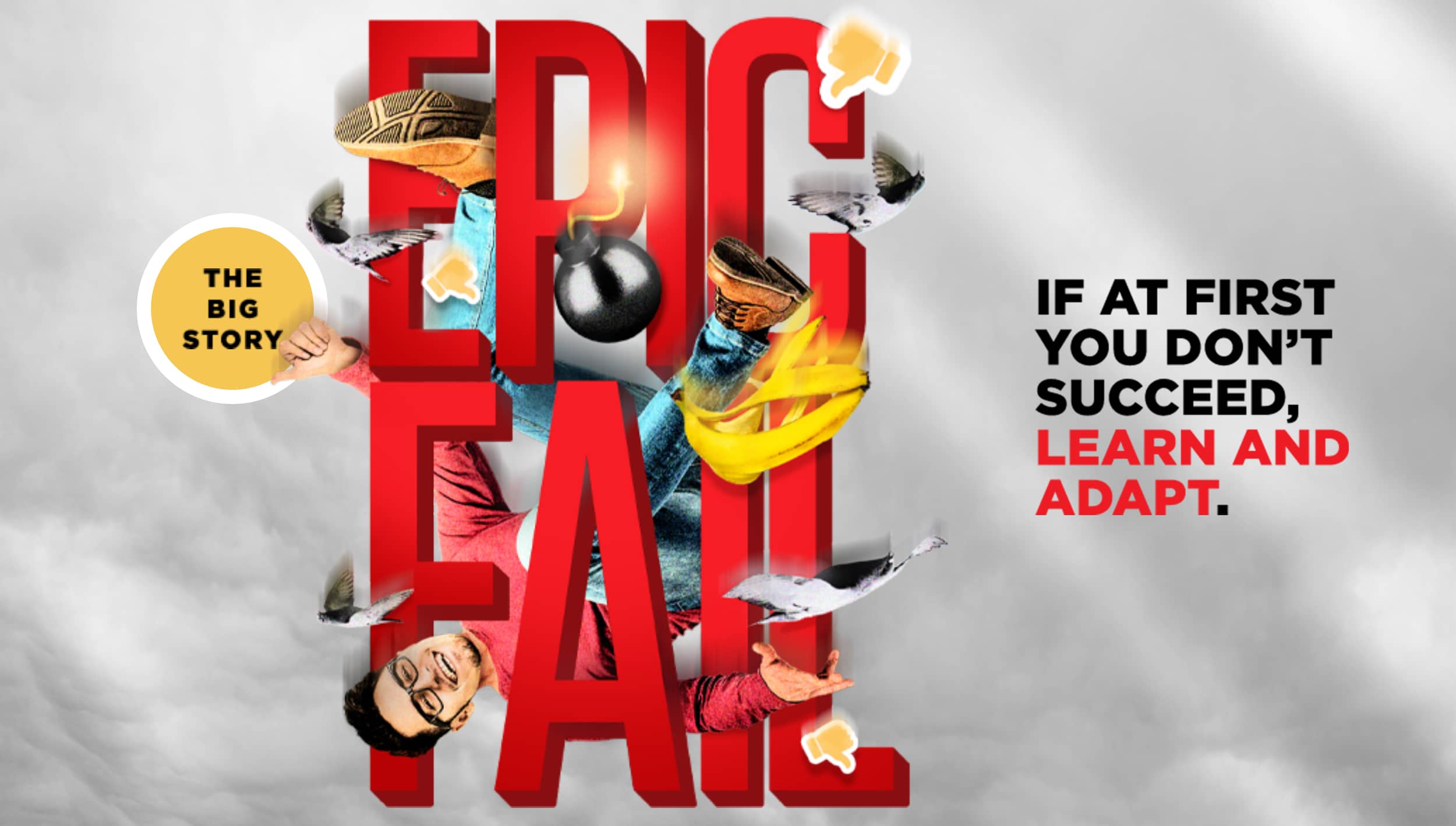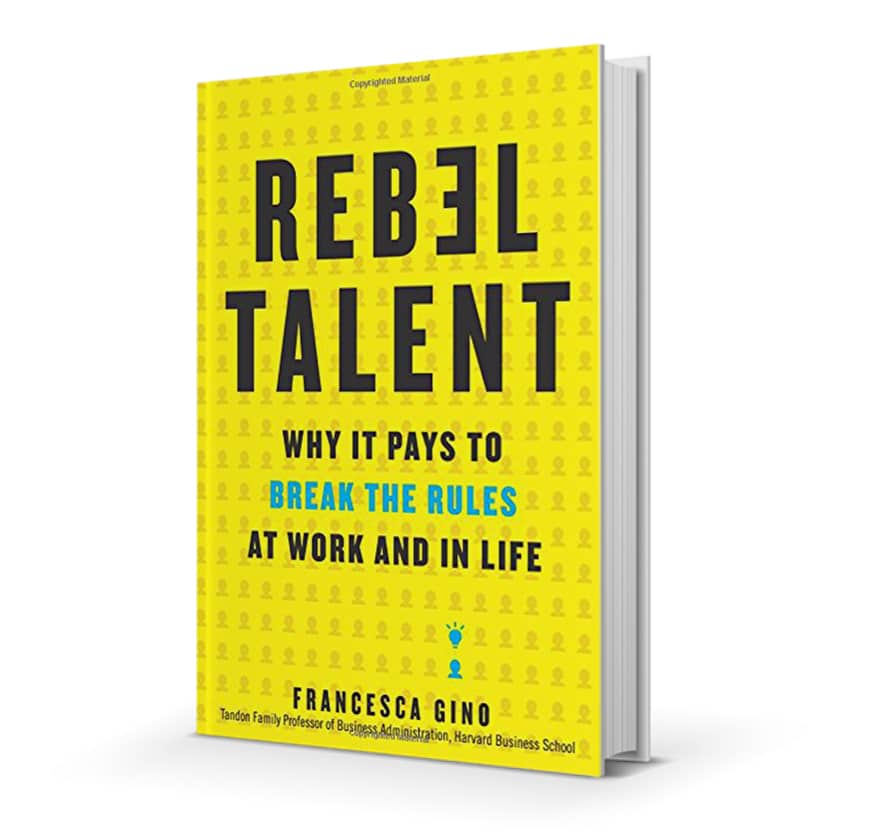
Business Blunder? Here’s How to Make the Most of It
Learn from your missteps, bounce back, and prevent problems from repeating themselves (special bonus: real-world screen printing redemption stories).
Published
5 months agoon
WHERE ONCE FAILURE was the domain of losers, it’s now a cause célèbre, a hard-earned badge of redemption and authenticity.
In ads for sports shoes, athletes relish recalling how many times they missed the winning shot. In magazine articles, CEOs take pride in recalling their blunders.
Politicians and celebrities seem happy to relive their lowest moments. In short, the benefits of failure shouldn’t be news to us. Failure spurs us to innovate, to prevent recurring mistakes, and to uncover new opportunities.
However, failure comes with tangible costs: wasted time, wasted money, and potentially even the loss of your business (or worse). Plus, even minor missteps can be painful. Disappointment cuts deep, and we stake so much psychologically on being right that denial and blame-shifting remain our default responses when things go wrong.
As a result, despite all the good talk about failure, most businesses continue to do the opposite. They punish mistakes, shoot the messenger, deny errors, blame others, make no systematic effort to study the problem, and basically ignore whatever messages failure has to teach. In the process, they double down on their errant course of action, stifle risk-taking, and take a step toward creating the very thing they are trying to avoid: a terminal misstep.
Although there is no way to take the pain out of failure, you can resolve to avoid making these same mistakes. Read on for insights about how make the best of a bad situation when things go awry, as well as ways to mitigate or even prevent the worst of the damage.

LET IT SINK IN
01German statesman Otto von Bismarck is often reported to have said, “Only a fool learns from his own mistakes. The wise man learns from the mistakes of others.”
However, recent research indicates first-hand experience helps us learn better. Like riding a bike, there are just some things you can’t learn from a book or YouTube video. Experiencing failure builds resilience.
“All the advice tells you not to dwell on your mistakes, to not feel bad,” says Selin Malkoc, co-author of the study and a professor of marketing at Ohio State University’s Fisher College of Business. “But we found the opposite. When faced with a failure, it is better to focus on one’s emotions – when people concentrate on how bad they feel and how they don’t want to experience these feelings again, they are more likely to try harder the next time.”
MAINTAIN PERSPECTIVE
02 Thinking philosophically about failure can help ensure we respond constructively. Keep in mind that in some mysterious way, the possibility of failure is what makes games worth playing, business worth pursuing, and ultimately life worth living. When there is no challenge, the joy evaporates (try playing a video game designed for four-year-olds and see how long that stays fun!).
The poet Rainer Maria Rilke summed it up nicely: “The purpose of life is to be defeated by ever greater things.” In business, those challenges are waiting every day. Go down valiantly.
KNOW WHAT FAILURE LOOKS LIKE
03 Recognizing failure can be surprisingly difficult. We’ve been trained that persistence pays off, so it feels wrong to cut our losses and label an idea a failure. “Decide what success and failure would look like before you launch an initiative,” says Wharton Business School’s Rita Gunther McGrath, noting that some big corporations build exit strategies into their projects to ensure that doomed or resource-sucking efforts do not drag on.
“Being able to recognize a failure just means that you’ll be able to re-cast it into something more likely to succeed,” adds Tim Harford, author of the book Adapt: Why Success Always Starts With Failure. In such instances, feedback — either in the form of data or third-party reviews — is essential for determining which experiments have succeeded and which have failed. “Get advice, not just from one person, but from several,” he says.
BEWARE YOUR BIASES
04 The human capacity for self-deception is profound. It helps to be aware of the kinds of biases that can undermine a proper evaluation of a project. Among the most common psychological blind spots related to failure are the “God complex” (feelings of infallibility), chasing your losses (taking bigger risks to win back lost money), and hedonic editing (when we try to convince ourselves that a mistake doesn’t matter or find some way to reinterpret failures as successes).

DEBRIEF
05 When a business venture fails, sure, it sucks. When a military expedition fails, people die. The life-or-death nature explains the military’s relentless “after-action reviews” (AARs) of each combat encounter and combat-training exercise. “As in business, the reasons for success or failure in combat often are not clear,” writes behavioral scientist Francesca Gino, author of Rebel Talent: Why It Pays to Break The Rules at Work and In Life. “AAR participants discuss four key questions: What did we set out to do? What actually happened? Why did it happen? What are we going to do next time?”
Failure reviews aren’t fun, but you must resist the temptation to sweep little disasters under the carpet. You could lose a valuable learning opportunity. “Reviews work best when they are fast and to the point; take place frequently, through good times and bad; and are forward-looking, with an emphasis on learning, not assigning blame,” write Julian Birkinshaw and Martine Haas in Increase Your Return On Failure.
KEEP A FAILURE RÉSUMÉ
06 A failure résumé – or anti-portfolio, CV of failures, or whatever name you give it – is a simple idea: When you fail, write it down. The idea is not to wallow in negative feelings. “Honestly analyzing one’s failures can lead to the type of introspection that helps us grow – as well as show that the path to success isn’t a straight line,” writes Tim Herrera in his “Smarter Living” column for the New York Times. Documenting failures can also help validate your achievements by serving as a reminder of how hard you’ve struggled to succeed.
SWITCH IT UP
07 A crucial question to ask yourself about your mistakes is, “Am I failing differently each time?” says Steven Levitt, author of the business bestseller Freakonomics. For all our talk here about failure, what we are actually talking about is learning. Fail the same way over and over, and you’re clearly not learning.

EMBRACE RISK
08The more you try, the more you’re likely to fail – and that’s OK. As 3M’s legendary chairman William McKnight once said, “The best and hardest work is done in the spirit of adventure and challenge … Mistakes will be made.”
A risk-averse culture, on the other hand, is dangerous. Once you and your team quit innovating and become guardians of the status quo, the end is likely in sight. “One division head I worked with would say to his team members during their performance reviews, ‘Show me your scrap heap,’” recalls Wharton’s Gunther McGrath. “The request perfectly conveys the idea that high achievers will, of necessity, try some things that don’t work out.”
DON’T POINT FINGERS
09 Building a culture of risk requires resisting natural instincts to immediately assign blame. When Amy Edmondson, a professor in leadership and management at Harvard Business School, discusses failure with executives, she often asks them to consider her Spectrum of Reasons for Failure. This list of causes ranges from deliberate deviation to thoughtful experimentation. “When I ask executives to estimate how many of the failures in their organizations are truly blameworthy, their answers are usually in single digits – perhaps 2 percent to 5 percent,” she reports. “But when I ask how many are treated as blameworthy, they say (after a pause or a laugh) 70 to 90 percent. The unfortunate consequence is that many failures go unreported and their lessons are lost.”
DON’T FRET THE MORAL HAZARD
10 If people aren’t blamed for failures, what will ensure that they try as hard as possible to do their best work? What stops a business from descending into anything-goes chaos? According to Edmonson, such concerns are based on a false dichotomy: “In actuality, a culture that makes it safe to admit and report on failure can – and in some organizational contexts must – coexist with high standards for performance,” she writes.
Encouraging failure doesn’t mean abandoning supervision, quality control, or respect for sound practices. In fact, it’s just the opposite, argue write Richard Farson and Ralph Keyes, authors of Whoever Makes The Most Mistakes Wins. “Managing for failure requires executives to be more engaged, not less. Astute managers mark the daily progress of small successes and failures with an evenhanded, open curiosity about the lessons learned and the next steps to take.”
Advertisement
FOCUS ON PROCESS
11According to Dan Ariely, author of the bestseller Irrationally Predictable, people tend to focus too much on the outcome rather than the process. “Sometimes the idea is very good but the outcome is negative,” he writes. Emphasizing systems over goals and analysis over blame creates an encouraging environment for experimenting and generating good ideas.
Edmonson concurs: “The key is to insist on developing a clear understanding of what happened – not of ‘who did it’ – when things go wrong.” Farson and Keyes recommend eschewing both praise and blame. “Failure-tolerant leaders avoid giving either praise or criticism, preferring to take a nonjudgmental, analytical posture as they interact with staff,” they write. “And they try to root out the destructive competitiveness built into most organizations.”
HAIL THE BAD-NEWS MESSENGER
12“The biggest mistake you can make as a leader is to shoot the messenger and bury the bad news,” write Birkinshaw and Haas. “Big, painful, expensive failures are easy to spot. But in many organizations, any failure that can be hidden is hidden as long as it’s unlikely to cause immediate or obvious harm.”
The goal should be to identify failure early, before it mushrooms into disaster. Among the ways to do this: creating a shared understanding around the types of failures that employees can expect to happen at work, being accessible as a leader (physically and in terms of personality), and rewarding the messenger who brings up bad news.
FAIL FROM THE FRONT
13Far from revealing weakness, admitting mistakes shows a leader’s self-confidence and helps forge closer ties with employees. “A blunder admitted is empathy earned,” Farson and Keyes write. “Leaders who don’t cover up their errors reveal themselves as human – they become people whom others can admire and identify with.” Adds Edmonson: “Only leaders can create and reinforce a culture that counteracts the blame game and makes people feel both comfortable with and responsible for exposing and learning from failures.”
SHARE WHAT YOU LEARN
14 Although reflecting on individual failures is useful, the real payoff comes from sharing lessons across the organization – or even better, ingraining them into in institutional memory. At Coca-Cola, stories about the failure of New Coke are still told 30 years on. Former CEO Roberto Goizueta got years of one-liners from the fiasco. “Admitting his mistake conveyed to his employees better than a hundred speeches or a thousand memos that ‘learning failures,’ even on a grand scale, were tolerated,” Farson says.
Today, traditional soft drinks account for less than two-thirds of Coke’s business. “They saw the handwriting on the wall, and they evolved into ready-to-drink teas and coffees and juices and dairy products. Coca-Cola knew it was time to reinvent themselves; to transform from one thing into another. This is why – after a continuing series of mistakes, failures, and course corrections – they will continue to thrive,” says Roy H. Williams, author of The Wizard of Ads.
GIVE UP THE REINS
15 It’s not just at the organizational level that failure can be a “gift.”
Individuals – including your employees – also can benefit from its didactic embrace. The problem is many managers are what psychologists call “over-functioners” – they spring into fixing mode, taking control and attacking the issue. As with raising kids, it often helps to let underlings fail to allow them to develop, even if it creates some short-term anxiety or uncertainty. When a person is struggling, ask, “What do you think you should do? Go try it and I’ll give you some ideas, and then you see how it goes.”

USE SYMBOLIC RITUALS
16 Heroic Failure Awards, Failure Walls (a space in your back room for sharing “growth lessons”), or a Failure Hour (a weekly meeting devoted to improving what went wrong) can help create an environment in which failures are openly and seriously discussed. “Something magical happens to failure when it’s openly acknowledged,” writes business author Jeff Stibel in a column for Bizjournals.com. “Paradoxically, it becomes less of a big deal.”
Resolving to make the most of bad situations is not the same as embracing failure. On the contrary, a truly spectacular fail – or even series of cascading, minor missteps – can burn holes in the budget, destroy morale, infuriate customers, and sometimes lead to legal trouble or even tragedy. For small business owners, there is the legitimate risk that a major failure – choosing a wrong location, expanding to a new market, or opting not to adopt a new technology – could mean the end of their business. Our final 10 tips cover how to minimize the damage (and possibly even prevent a truly epic fail from ever happening):
CONTAIN THE DOWNSIDES
17 To enjoy the benefits of failure, you’ve got to survive the experience. To the extent you can control things, try to fail small and cheaply, perhaps by proceeding incrementally with any risky new venture. Always ask, “What is the minimum viable experiment?” Williams says. It also helps to stick to “adjacencies,” or areas where you have some related business experience. The business world is littered with the dead projects of companies that strayed too far from their core competencies.
AIM LOW
18 A common mistake even at big corporations is to test new products or services under optimal conditions, Edmondson says. Take the example of a new website rollout. Rather than assume visitors will be tech-savvy, the best approach would be to test the site with limited support, unsophisticated customers, and old computers or mobile phones. Rather than proving that everything could go right, the goal should be to discover anything that could possibly go wrong. “Of course, the managers in charge would have to have understood that they were going to be rewarded not for success, but rather for producing intelligent failures as quickly as possible,” she says.
MAKE BACKUP PLANS
19 “Expose yourself to lots of different ideas and try lots of different approaches on the grounds that failure is common,” Harford writes. “This approach is far less intimidating than trying to come up with the best idea ever. You need Plan B, Plan C, Plan D. You need a full quiver of arrows.” A fallback position not only makes it easier to be wrong, but also enables taking away a wider range of lessons from each mistake, he says. Ideally, you want to try a mix of off-the-wall ideas and by-the-book practices.

USE CHECKLISTS
20 In his book The Checklist Manifesto, Dr. Atul Gawande argues that in our complex modern world, failure results not so much from ignorance (not knowing enough about what works) as from ineptitude (not properly applying what we know works). His solution? Checklists.
In medicine, a field where the available well of learning expands exponentially every year, the problem is “making sure we apply the knowledge we have consistently and correctly,” Gawande says. A recent study in UK hospitals suggested that wider use of checklists might prevent a staggering 40 percent of deaths during treatment. If surgeons can fill out checklists, the rest of us should probably be willing to run our expertise by the numbers as well.
REVISIT AND REBOOT
21 Revisit your old ideas regularly. For one, the lessons of past failures are likely still relevant. For another, circumstances change. The time for these old ideas may well have arrived.
Advertisement
IMAGINE FAILING BEFORE YOU FAIL
22 Post-mortems are a great way to examine what went wrong with a venture. The problem, as the name suggests, is that the “patient” has already died, sometimes in an embarrassing “why didn’t we think of that?” way.
To prevent such failures, the Nobel Prize-winning business author Daniel Kahneman suggests something known as a “pre-mortem.” Before launching a new venture, tell your team to imagine they are in the future looking at the aftermath of the disaster. Why did it flop so spectacularly?
This approach removes pressure about being the “skunk at the picnic” – that is, seeming disloyal by being less than positive about the project. In fact, it turns the session into a competition to find ever more convincing reasons for a hypothetical failure. With all these possible mistakes out on the table, you might just be able to make an adjustment that saves your project from actually sinking.
IF IT AIN’T BROKE, EXPERIMENT
23 Understanding why you’re successful is as important as understanding what causes mistakes. So, keep looking at data even when things are going well.
“Celebrate success, but examine. Ironically, casting a critical eye on your success can better prepare you to avoid failure,” write Francesca Gino and Gary Pisano in the Harvard Business Review (“Why Leaders Don’t Learn from Success”). Gino and Pisano say the right question for leaders of learning organizations to ask is not “What are we doing well?” but rather “What experiments are we running?”
DON’T LET FEAR HOLD YOU BACK
24 In her latest book, Big Magic, Elizabeth Gilbert notes that fear can be a sign that something is important to you. The trick, if you can do it, isn’t to ignore fear, or to try to conquer it, and definitely not to obey it, but to treat it like an annoying younger sibling and make space for it. She uses the analogy of a road trip. “Fear always comes along for the ride, and that’s fine – but that doesn’t mean you need to let it anywhere near the steering wheel.”
DON’T LET FAILURE DEFINE YOU
25 A lot of us look to athletes for inspiration. But according to British sports psychologist James Hamilton, many elite athletes have a pretty unhealthy view of success and failure, associating defeat with an all-around failure of the self. To be sure, this perspective can fuel a drive to put up with high levels of discomfort and deprivation, but it can also result in risk avoidance and self-blame when things don’t pan out. Take a healthier view and remember any failure “stands separate” from you, he says.
FIND A PODCAST
26 It may sound a little cheesy, but when things aren’t going well, there’s a fabulous world of inspiration out there – podcasts, YouTube commencement speeches, TED talks, and more. Plenty of great people who have experienced exactly what you’re going through can provide a pick-me-up, reassurance, or even tactical guidance. Consider curating a collection of these kinds of resources for moments when you need a boost to keep believing in yourself.
Print, Fail, Prevail
The Brain Squad shares examples of fiascos with happy endings.
As the old saying goes, everyone makes mistakes; how you respond is what defines you.
In a recent Brain Squad survey, many members shared a similar philosophy as Larry Mays of Mays Marketing Group. “We don’t just print whatever we are sent,” he says about the Erie, Pennsylvania business. Rather, the priority is building a long-term relationship. That means treating every order like the only order. “We are meticulously careful to provide proofs for every order so the customer can confirm details,” Mays says. “We also work hard to make sure that what the customer is asking for looks good. If not, we advise in advance.”
However, when customers are truly unhappy, the company is quick to replace the merchandise, and “almost always at our cost,” he says.
Shawn LaFave of North Georgie Promotions feels similarly. “If we make a mistake, we usually take care of it without the client ever knowing about it. In the cases where product is sent from a supplier to the client, we get them replaced ASAP. We handle each incident the way we would like it done if we were the customer.”
Others echoed this sentiment. Screen printers must do what it takes to satisfy the customer “regardless of whose fault it is,” says Jason Feather at Aka. Ditto for Ian Graham at Feels So Good, who says the company “always strives” to satisfy customers, “which means doing a reprint if they’re unhappy with the quality of the print or garment when financially possible.” As for Charlie Taublieb of Taublieb consulting, “I don’t have a problem letting my clients know when I have gone in the wrong direction and do what I can to fix the issue.”
The following examples demonstrate that adopting this philosophy is often a case of “easier said than done.” However, they also show that the benefits of a strengthened relationship and repeat orders can more than justify added time and expense of getting it right. And barring that, there’s always something to learn.

Flip the Script
We had a new client who ran a large front design that looked like it should be a back-of-shirt design, and a small design on the back of the shirt that looked like it should have been on the front. Our printer says he read the art notes and saw the mockup, but he still ran the shirt designs opposite of the notes. The client was less than pleased and brought the shirts back, and we reprinted with the correct design layouts. The client still uses us today. — Daysha Rojo, SketchShe Branding
Positive Vibes
I do a lot of commercial paper printing. I did some listing sheets for a realtor. I did a test print and noticed an error. So they fixed it and sent a new file. I did a new printed proof – looked great – and then ran the old file. I delivered it Friday and went home for the weekend. They caught the blunder, but I was already gone. They were crushed. On Monday I went into their office and told them how sorry I was. When my wonderful client saw how angry and upset I was at myself, she was more than happy to give me another chance. She followed me when I left that job and went out on my own. What matters is personal attention and care. Customer service is a major priority! — Carroll Berg, Berg Ink
Make it Work
We accepted a 24-hour rush order, but the shirts came in the wrong color. We substituted with a lesser-quality tee that was in the [right] color and removed any rush fees. We then delivered the shirts to the customer’s doorstep so they would have them to pass out first thing the next morning. The customer was understanding and happy they had something to pass out. They have since reordered twice! — Davis Slagle, B Graphics LP
Hard Swallow
Mistakes happen. Regardless of whose fault it is, as a business owner you have to take action and give the customer what they ordered, to perfection, and in record time. We had a simple spacing issue in a design that was our art department’s fault. It went through our screen department, then print, and then into the customers hands. It was not a huge issue, but nonetheless a mistake we had to own up to and eat the cost of for a reprint. This is a cost most of my “competitors” will not eat, but for us, the customer comes first. Future orders proved this to be a smart move. — Jason Feather, Aka
Nitpick Negated
We had a 1,500-piece poster job, and the client was unhappy with a TINY pinhole on 400 of the prints. So we’re reprinting those rather than losing the client by holding fast and refusing. — Ian Graham, Feels So Good
Reframed Relationships
I sold some frames to a client that were bad. I offered to reimburse him for the frames that wee bad out of my pocket. I don’t work with the company that sold me the frames anymore. — Charlie Taublieb, Taublieb Consulting
Free Shirts for All
We made some shirts for a tech wiz who lived in the area who had cashed in early on with a game that went viral and bought a couple of nerd bars in Vancouver. Never actually met him – he was too busy, and they needed the stuff in a hurry for some reason – long story short, he provided different art for various shirts, and one design wasn’t supposed to be printed the way it was wanted. We would have caught it if we had refused to be rushed, if client approval was required, and if our artist had thought for a minute about negative and positive images discharged on dark shirts. I think the customer’s exact words when I talked to him were, “I wouldn’t clean my car with these.” He was pissed. We redid it, ate the loss, never printed for him again, and learned to stop and look both ways before crossing the street to print the job. Oh, and both his bars went broke and closed. Family and friends had unlimited dk grey heather AA shirts with a cool image. Nobody died. — Andy MacDougall, MacDougall Screen Printing Ltd.
Speedy Shipment
Several years back a shipment for an event was on a FedEx plane that crashed. FedEx notified us, and we ordered the shirts and shipped them to arrive at the event Saturday morning. The client could not believe we pulled it off. — Marshall Atkinson, Atkinson Consulting

Camo Conundrum
Imagine this: An order is coming for 1,000 high-end camouflage hoodies. The blank cost is $60 each. Camo can be really tricky to print as the camo colors can migrate into the ink, so we said we wouldn’t print unless we had a few samples to test. They provided us with them. We printed a few different ways, took good notes, and waited for color bleed. In the end we developed a method that the white stayed white and all was good. We accepted the job. When the hoodies arrived, it turns out they were made in a different factory from the samples – even a different country. No one thought to inform us. We didn’t think to ask. We took out our notes and printed 1,000 hoodies exactly as we had done in our successful sampling. The next day when bagging them, we noticed small amounts of dye migration from the camo into the white ink. The day after that, more, then more the following day. By day four it was brutal. It looked horrible. We had to call the customer to come over and look at the disaster. We both felt sick. In the end we had to bin the whole lot. They weren’t salvageable. We worked out a cost split on the loss. We both took equal blame – split it 50/50. It stung. Especially because I felt like we did everything right to avoid the mistake. But you have to stand behind your failures as well as your successes. The customer stuck with us, and his company has become one of our biggest revenue generators. Why did they stick with us? These were his words: “You coulda just shipped them and gotten paid since you were shipping direct to the fulfillment center. It would have been months before I started getting phone calls. I appreciate that you put my reputation ahead of your pocketbook, and since I paid half a wheelbarrow full of money to obtain that information, why would I go anywhere else?” — Matthew Pierrot, GetBOLD
SPONSORED VIDEO
Let’s Talk About It
Creating a More Diverse and Inclusive Screen Printing Industry
LET’S TALK About It: Part 3 discusses how four screen printers have employed people with disabilities, why you should consider doing the same, the resources that are available, and more. Watch the live webinar, held August 16, moderated by Adrienne Palmer, editor-in-chief, Screen Printing magazine, with panelists Ali Banholzer, Amber Massey, Ryan Moor, and Jed Seifert. The multi-part series is hosted exclusively by ROQ.US and U.N.I.T.E Together. Let’s Talk About It: Part 1 focused on Black, female screen printers and can be watched here; Part 2 focused on the LGBTQ+ community and can be watched here.
You may like
Advertisement

Atlantis Headwear Goes Solar for Sustainable Future

Comfort Colors Announces New Proprietary Dyeing Process Called “Pigment Pure”

10 Production Scheduling Secrets That Will Have Your Team Ready to Rock
Advertisement
Subscribe

Bulletins
Get the most important news and business ideas from Screen Printing magazine's news bulletin.
Advertisement
Most Popular
-

 Case Studies2 months ago
Case Studies2 months agoHigh-Density Inks Help Specialty Printing Take Center Stage
-

 Art, Ad, or Alchemy2 months ago
Art, Ad, or Alchemy2 months agoF&I Printing Is Everywhere!
-

 Andy MacDougall2 months ago
Andy MacDougall2 months agoFunctional and Industrial Printing is EVERYWHERE!
-

 Columns3 weeks ago
Columns3 weeks ago8 Marketing Mistakes Not to Make When Promoting Your Screen Printing Services Online
-

 Editor's Note3 weeks ago
Editor's Note3 weeks agoLivin’ the High Life
-

 Marshall Atkinson3 weeks ago
Marshall Atkinson3 weeks agoHow to Create a Winning Culture in Your Screen-Printing Business
-

 Thomas Trimingham2 months ago
Thomas Trimingham2 months ago“Magic” Marketing for Screen Printing Shops
-

 Case Studies3 weeks ago
Case Studies3 weeks agoScreen Printing for Texture and Depth













